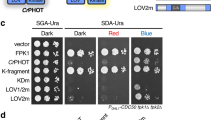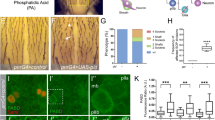Abstract
The rolling blackout (rbo) gene encodes an integral plasma membrane lipase required for Drosophila phototransduction. Photoreceptors are enriched for the RBO protein, and temperature-sensitive rbo mutants show reversible elimination of phototransduction within minutes, demonstrating an acute requirement for the protein. The block is activity dependent, indicating that the action of RBO is use dependent. Conditional rbo mutants show activity-dependent depletion of diacylglycerol and concomitant accumulation of phosphatidylinositol phosphate and phosphatidylinositol 4,5-bisphosphate within minutes of induction, suggesting rapid downregulation of phospholipase C (PLC) activity. The RBO requirement identifies an essential regulatory step in G-protein-coupled, PLC-dependent inositol lipid signaling mediating activation of TRP and TRPL channels during phototransduction.
This is a preview of subscription content, access via your institution
Access options
Subscribe to this journal
Receive 12 print issues and online access
$209.00 per year
only $17.42 per issue
Buy this article
- Purchase on Springer Link
- Instant access to full article PDF
Prices may be subject to local taxes which are calculated during checkout








Similar content being viewed by others
References
Bloomquist, B.T. et al. Isolation of a putative phospholipase C gene of Drosophila, norpA, and its role in phototransduction. Cell 54, 723–733 (1988).
Niemeyer, B.A., Suzuki, E., Scott, K., Jalink, K. & Zuker, C.S. The Drosophila light-activated conductance is composed of the two channels TRP and TRPL. Cell 85, 651–659 (1996).
Scott, K., Becker, A., Sun, Y., Hardy, R. & Zuker, C. Gqα protein function in vivo: genetic dissection of its role in photoreceptor cell physiology. Neuron 15, 919–927 (1995).
Hardie, R.C. Phototransduction in Drosophila melanogaster. J. Exp. Biol. 204, 3403–3409 (2001).
Montell, C. Visual transduction in Drosophila. Annu. Rev. Cell Dev. Biol. 15, 231–268 (1999).
Estacion, M., Sinkins, W.G. & Schilling, W.P. Regulation of Drosophila transient receptor potential-like (TrpL) channels by phospholipase C-dependent mechanisms. J. Physiol. (Lond.) 530, 1–19 (2001).
Minke, B. & Cook, B. TRP channel proteins and signal transduction. Physiol. Rev. 82, 429–472 (2002).
Hardie, R.C. Regulation of trp channels via lipid second messengers. Annu. Rev. Physiol. 65, 735–759 (2003).
Hardie, R.C. & Minke, B. The trp gene is essential for a light-activated Ca2+ channel in Drosophila photoreceptors. Neuron 8, 643–651 (1992).
Acharya, J.K., Jalink, K., Hardy, R.W., Hartenstein, V. & Zuker, C.S. InsP3 receptor is essential for growth and differentiation but not for vision in Drosophila. Neuron 18, 881–887 (1997).
Raghu, P. et al. Constitutive activity of the light-sensitive channels TRP and TRPL in the Drosophila diacylglycerol kinase mutant, rdgA. Neuron 26, 169–179 (2000).
Smith, D.P. et al. Photoreceptor deactivation and retinal degeneration mediated by a photoreceptor-specific protein kinase C. Science 254, 1478–1484 (1991).
Huber, A., Sander, P., Bahner, M. & Paulsen, R. The TRP Ca2+ channel assembled in a signaling complex by the PDZ domain protein INAD is phosphorylated through the interaction with protein kinase C (ePKC). FEBS Lett. 425, 317–322 (1998).
Liu, M., Parker, L.L., Wadzinski, B.E. & Shieh, B.H. Reversible phosphorylation of the signal transduction complex in Drosophila photoreceptors. J. Biol. Chem. 275, 12194–12199 (2000).
Chyb, S., Raghu, P. & Hardie, R.C. Polyunsaturated fatty acids activate the Drosophila light-sensitive channels TRP and TRPL. Nature 397, 255–259 (1999).
Hilgemann, D.W., Feng, S. & Nasuhoglu, C. The complex and intriguing lives of PIP2 with ion channels and transporters. Sci. STKE RE19 (2001).
Ordway, R.W., Pallanck, L. & Ganetzky, B. Neurally expressed Drosophila genes encoding homologs of the NSF and SNAP secretory proteins. Proc. Natl Acad. Sci. USA 91, 5715–5719 (1994).
Loughney, K., Kreber, R. & Ganetzky, B. Molecular analysis of the para locus, a sodium channel gene in Drosophila. Cell 58, 1143–1154 (1989).
van der Bliek, A.M. & Meyerowitz, E.M. Dynamin-like protein encoded by the Drosophila shibire gene associated with vesicular traffic. Nature 351, 411–414 (1991).
Shyngle, J. & Sharma, R.P. Studies on paralysis and development of second chromosome temperature sensitive paralytic mutants of Drosophila melanogaster. Indian J. Exp. Biol. 23, 235–240 (1985).
Kumar, M., Joseph, M. & Chandrashekaran, S. Effects of mutations at the stambh A locus of Drosophila melanogaster. J. Genet. 80, 83–95 (2001).
Faulkner, D.L., Dockendorff, T.C. & Jongens, T.A. Clonal analysis of cmp44E, which encodes a conserved putative transmembrane protein, indicates a requirement for cell viability in Drosophila. Dev. Genet. 23, 264–274 (1998).
Martinez, C., De Geus, P., Lauwereys, M., Matthyssens, G. & Cambillau, C. Fusarium solani cutinase is a lipolytic enzyme with a catalytic serine accessible to solvent. Nature 356, 615–618 (1992).
Cygler, M. & Schrag, J.D. Structure as basis for understanding interfacial properties of lipases. Methods Enzymol. 284, 3–27 (1997).
Bisogno, T. et al. Cloning of the first sn1-DAG lipases points to the spatial and temporal regulation of endocannabinoid signaling in the brain. J. Cell Biol. 163, 463–468 (2003).
Hotta, Y. & Benzer, S. Abnormal electroretinograms in visual mutants of Drosophila. Nature 222, 354–356 (1969).
Pak, W.L., Grossfield, J. & White, N.V. Nonphototactic mutants in a study of vision in Drosophila. Nature 222, 351–354 (1969).
Agam, K. et al. Metabolic stress reversibly activates the Drosophila light-sensitive channels TRP and TRPL in vivo. J. Neurosci. 20, 5748–5755 (2000).
Pearn, M.T., Randall, L.L., Shortridge, R.D., Burg, M.G. & Pak, W.L. Molecular, biochemical, and electrophysiological characterization of Drosophila norpA mutants. J. Biol. Chem. 271, 4937–4945 (1996).
Juusola, M. & Hardie, R.C. Light adaptation in Drosophila photoreceptors: II. Rising temperature increases the bandwidth of reliable signaling. J. Gen. Physiol. 117, 27–42 (2001).
McKay, R.R., Zhu, L. & Shortridge, R.D. Membrane association of phospholipase C encoded by the norpA gene of Drosophila melanogaster. Neuroscience 61, 141–148 (1994).
Yoshioka, T., Inoue, H. & Hotta, Y. Absence of phosphatidylinositol phosphodiesterase in the head of a Drosophila visual mutant, norpA (no receptor potential A). J. Biochem. 97, 1251–1254 (1985).
Preiss, J. et al. Quantitative measurement of sn-1,2-diacylglycerols present in platelets, hepatocytes, and ras- and sis-transformed normal rat kidney cells. J. Biol. Chem. 261, 8597–8600 (1986).
Hardie, R.C. & Raghu, P. Visual transduction in Drosophila. Nature 413, 186–193 (2001).
Minke, B. & Selinger, Z. Inositol lipid pathway in fly photoreceptors: excitation, calcium mobilization and retinal degeneration. Prog. Retin. Res. 11, 99–124 (1991).
Wu, L., Niemeyer, B., Colley, N., Socolich, M. & Zuker, C.S. Regulation of PLC-mediated signalling in vivo by CDP-diacylglycerol synthase. Nature 373, 216–222 (1995).
Hardie, R.C. et al. Calcium influx via TRP channels is required to maintain PIP2 levels in Drosophila photoreceptors. Neuron 30, 149–159 (2001).
Rodriguez de Turco, E.B. et al. Diacylglycerol kinase epsilon regulates seizure susceptibility and long-term potentiation through arachidonoyl-inositol lipid signaling. Proc. Natl Acad. Sci. USA 98, 4740–4745 (2001).
Yoshioka, T., Inoue, H. & Hotta, Y. Absence of diglyceride kinase activity in the photoreceptor cells of Drosophila mutants. Biochem. Biophys. Res. Commun. 119, 389–395 (1984).
Inoue, H., Yoshioka, T. & Hotta, Y. Diacylglycerol kinase defect in a Drosophila retinal degeneration mutant rdgA. J. Biol. Chem. 264, 5996–6000 (1989).
Broadie, K. Functional assays of the peripheral and central nervous systems. in Drosophila Protocols (ed. W.A.M. Sullivan & R.S. Hawley) 297–312 (Cold Spring Harbor Laboratory Press, Cold Spring Harbor, New York, USA, 2000).
Fukami, K. et al. Antibody to phosphatidylinositol 4,5-bisphosphate inhibits oncogene-induced mitogenesis. Proc. Natl Acad. Sci. USA 85, 9057–9061 (1988).
Bligh, E.G. & Dyer, W.J. A rapid method of total lipid extraction and purification. Can J Med Sci 37, 911–917 (1959).
Acknowledgements
We thank the Drosophila Bloomington Stock Center for supplying stocks; T. Jongens for cmp44E RFII pBluescript vector; T. Jongens, S. Chandrashekaran, C. Montell, H. Li, R. Hardie and W. Pak for flies, including cmp44E, stmA, trp343, trpl302 and norpA mutants; C. Sanders for DAG kinase; R. Shortridge for advice about PLC assays; R. Mohrmann for discussions, useful comments and help in generating figures and L. Yang for assistance in sequencing mutant alleles. This study was supported by US National Institutes of Health grant GM54544 to K.B.
Author information
Authors and Affiliations
Corresponding author
Ethics declarations
Competing interests
The authors declare no competing financial interests.
Supplementary information
Supplementary Fig. 1
stmA, cmp44E and rbo mutants are allelic to each other, based on both lethality and conditional blindness complementation studies. (a)"*" indicates phenotype was fully rescued by genomic rbo-egfp expression. A single naming strategy was adopted for all mutant alleles of the locus, as indicated. (b) Representative traces showing the loss (top) and genomic rescue (bottom) of phototransduction in rbo mutants. (PDF 266 kb)
Supplementary Fig. 2
RBO dendrogram. A dendrogram generated by Clustal W representing the relationship of RBO homologs from multiple species. A single rbo gene is present in both Drosophila melanogaster (Dmrbo) and Anapheles gambiae (Agrbo). The closest homologs are two genes present in both human (Hsrbo1,2) and mouse (Mmrbo1,2), and, more distantly, a single gene in C. elegans (Cerbo). Homologs are present in yeast (Scrbo). The outlier groups contain homologs from Arabidopsis (Atrbo) and rice (Osrbo). (PDF 300 kb)
Supplementary Fig. 3
RBO is a predicted lipase. The RBO protein contains the domain structure of a lipolytic enzyme. Three highly-conserved lipase functional motifs (His, Ser and Asp/Glu active sites) contain the catalytic triad of His, Ser, and Asp/Glu residues, respectively. The consensus motif "GXSXG" is found in the Ser active site. The mutation site in rbots1 is indicated. (PDF 40 kb)
Supplementary Fig. 4
PLC activity is normal in rbo mutant head extracts. (a) Schematic diagram of the Drosophila phototransduction pathway. Light activation of rhodopsin (Rh) activates Gq, which activates PLC. PLC hydrolyzes PIP2 into DAG and IP3 in the microvillar membrane. DAG either directly activates TRP/TRPL channels or is further hydrolyzed by DAG lipase to produce PUFAs, which in turn activate TRP/TRPL channels. DAG Kinase (DGK; I) converts DAG to phosphatidic acid (PA), which is then recycled to synthesize CDP-DAG via CDP-DAG synthase (II) in the subrhabdomeric cisternae. CDP-DAG is converted to PI by phosphatidylinositol synthase (III) to form PI. PI is then transported back to the microvillar membrane by PI transport protein (IV) and serially phosphorylated by PI kinase and PIP kinase (V,VI) to reproduce PIP2. Dotted lines indicate hypothetical pathways. (b) PLC activity assay from head extracts (see Methods) of wildtype (WT), rbots1/rbo2 mutants (rbo) and PLC norpA null mutants (norpAP24) at 25°C and 37°C, as indicated. Higher temperature caused a consistent increase in PLC activity levels in both WT and rbo mutants. The two genotypes were indistinguishable. The PLC null norpAP24 had negligible PLC activity, <1% of either WT or rbo mutants. (PDF 230 kb)
Rights and permissions
About this article
Cite this article
Huang, FD., Matthies, H., Speese, S. et al. Rolling blackout, a newly identified PIP2-DAG pathway lipase required for Drosophila phototransduction. Nat Neurosci 7, 1070–1078 (2004). https://doi.org/10.1038/nn1313
Received:
Accepted:
Published:
Issue Date:
DOI: https://doi.org/10.1038/nn1313
This article is cited by
-
Rare deleterious mutations of the gene EFR3A in autism spectrum disorders
Molecular Autism (2014)
-
Phototransduction in Drosophila
Science China Life Sciences (2012)
-
A neuroscientist's guide to lipidomics
Nature Reviews Neuroscience (2007)
-
Phototransduction and retinal degeneration in Drosophila
Pflügers Archiv - European Journal of Physiology (2007)
-
Lipid regulation of the synaptic vesicle cycle
Nature Reviews Neuroscience (2005)



